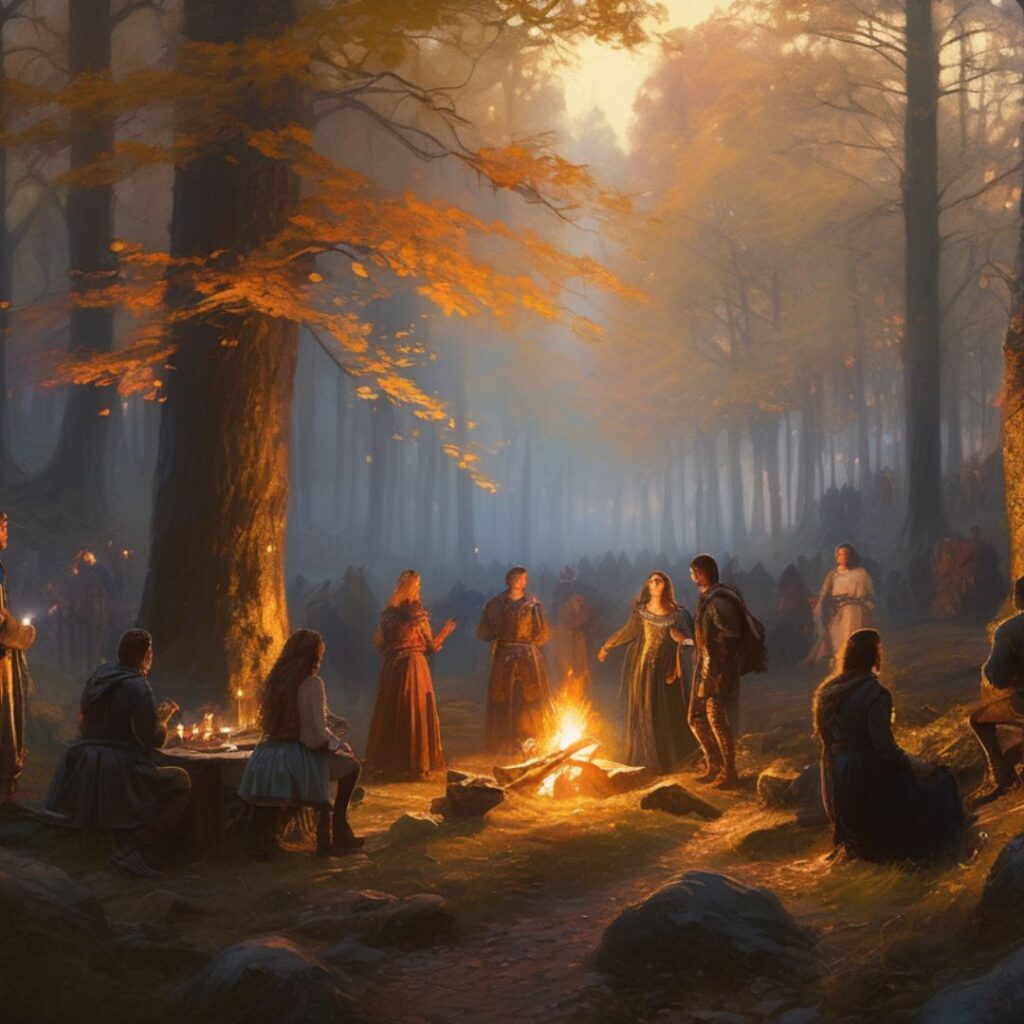Celtic mythology cradles all our modern works of fiction , but also our medieval and modern folklore. With its rich and diverse pantheon of gods and goddesses, it is one of the most complicated to understand due to the absence of writing by the Druids. The sources are therefore generally foreign, such as those of Roman scholars | or more recent, thanks to the survival of insular Celtic cultures (Ireland, Scotland, Wales, Brittany, etc.).
These deities, worshipped by ancient Celtic tribes across Europe, reflect a worldview deeply rooted in nature and the interconnectedness of all things. In this article, we hope to introduce you to the captivating world of Celtic gods, exploring their stories, powers, and cultural significance as best we can.
Celtic Religion: A Unique Worldview
Before we delve into the details of individual deities, it is crucial to understand the context of Celtic religion. Unlike the great monotheistic religions or structured pantheons like that of ancient Greece, Celtic spirituality was deeply rooted in the natural world.
The Celts were not a unified empire, but rather a collection of tribes sharing similar beliefs and cultural practices. This diversity was reflected in their religious practices, with significant regional variations in rituals and even in the names and attributes of the gods.
However, they represent a founding base of European civilization, probably the most forgotten. The exhibition of the Celts of the Palazao-Grassi in the 80s, will go so far as to speak of the "first European cultural empire".
Moreover, Celtic religion saw man as an integral part of nature, rather than its master. This worldview, which resonates with many modern ecological philosophies, profoundly influenced the way the Celts interacted with their environment and conceived of their deities.
The Major Celtic Gods
1. Morrigan: The Goddess of War and Fate ⚔️
Morrigan, often depicted as a raven or crow, is one of the most iconic and fearsome figures in the Celtic pantheon. Known as the goddess of war, fate, and death, Morrigan played a crucial role in battles and determining the fate of warriors.
Her name, which means "Great Queen" or "Ghost Queen," speaks to her powerful and dark nature. Morrigan was often seen as a triple goddess , a recurring archetype in European folklore, and here manifested in three aspects: Badb (the crow), Macha (related to sovereignty and horses), and Nemain (frenzy). This trinity reflected the different facets of her power and influence.
On the battlefield, Morrigan was both feared and respected. She could strike fear into the hearts of enemies, while inspiring courage in her favored ones. Her battle cry was said to be able to paralyze an entire army. Beyond war, Morrigan was also associated with prophecy and sovereignty, emphasizing her role in determining the fate of individuals and kingdoms.
2. Dagda: The Almighty Father 🍻
Dagda, whose name means "the good god" or "the good god", was one of the most revered and powerful figures in the Celtic pantheon. Considered the father of all gods, Dagda embodied wisdom, fertility, magic and strength.

Often depicted as a burly man with a mighty beard, Dagda possessed several magical attributes. The most famous was his inexhaustible cauldron, capable of feeding an entire army without ever running out. He also carried a magical club that could both give and take life, symbolizing his power over the cycle of life and death. His enchanted harp had the power to control the seasons and emotions.
As a god of abundance and fertility, Dagda was closely linked to agricultural cycles and the prosperity of the land. His role as protector and provider made him a central figure in many rituals and celebrations, particularly those related to harvests and the renewal of nature. Dagda's benevolent nature, combined with his great power, made him a beloved and respected deity throughout Celtic culture.
3. Brigid: The Goddess of Many Talents 🔥
Brigid, also known as the Bride in Scotland, is a multifaceted goddess, revered for her wisdom, creativity, and healing powers. Her cult was so widespread and important that it survived Christianization, with Brigid later being equated with Saint Bridget in Irish Christian tradition.
As the goddess of poetry, crafts, and prophecy, Brigid was the patron saint of poets, blacksmiths, and healers. She was seen as a source of divine inspiration, able to instill creativity and skill in the arts and crafts. Her association with fire, a symbol of purification and transformation, was reflected in the sacred forges and eternal fires kept in her honor.
Brigid's role in healing was particularly important. She was invoked for the cure of illness, the protection of herds, and the fertility of the land. Sacred springs and wells were often dedicated to her, reflecting her connection with healing waters. The festival of Imbolc, celebrating the beginning of spring, was particularly associated with Brigid, marking the renewal of life after winter.
Christianized, she became Saint Bridget in Ireland, and her feast day is placed on February 1st.
4. Lugh: The Polymath God 📖
Lugh, known as the "Long-Handed God" or the "Master of All Arts," was one of the most versatile and admired deities in the Celtic pantheon. His name is associated with light, reflecting his role as a sun god, but his skills extended far beyond that.
He is also one of the rare pan-Celtic gods, and venerated throughout Celtic Europe, both continental and insular. On the continent, he is written "Lug".
Considered a master of all things, Lugh excelled in the arts, crafts, warfare, and magic. This versatility made him a central figure in many legends and rituals. According to Irish mythology, Lugh had to prove his many skills to be admitted to Tara, the home of the gods, demonstrating his mastery in each area.
The festival of Lughnasadh, celebrated in early August, was dedicated to Lugh. The celebration marked the beginning of the harvest season and was an occasion for athletic competitions, trade fairs and social gatherings. These festivities reflected the many aspects of Lugh: his solar nature (the heat of summer), his skills (the competitions) and his role in trade and prosperity (the fairs). However, very little ancient information about this celebration has come down to us.
Sometimes, Lugh is associated with a younger Odin, from whom he also takes some attributes: the spear, magic, and polymathy. As for the root "Lugh" it would mean "Luminous" in proto-European.

5. Cernunnos: The Horned God of Nature 🍂
Cernunnos. The best known, sometimes the most appreciated in our time. Often depicted with deer antlers, he is one of the most enigmatic and fascinating figures in the Celtic pantheon. Known as the "Horned God", he embodies the life force of wild nature, fertility and the cycle of the seasons.
One of his representations, sitting cross-legged like a Buddha, holding a snake in one hand and a torque in the other, intrigues us about his relationship to the mystical knowledge of the ancient Celts and to initiatory knowledge.
As the lord of animals, Cernunnos was considered the protector of wildlife and forests. His image, often surrounded by various creatures, symbolized the harmony between man and nature. This deep connection with the natural world made him a particularly important deity for hunters and forest communities.
The symbolism of Cernunnos extends beyond the physical world. His antlers, which fall and grow back each year, represented the cycle of death and rebirth in nature. This association with regeneration and transformation made him an important figure in rituals associated with the changing seasons, particularly the autumn equinox and the winter solstice.

6. Epona: The Goddess of Horses and Fertility 🐎
Epona holds a unique place in the Celtic pantheon as a goddess specifically associated with horses. Her worship was so widespread that it was even adopted by the Romans, making her one of the few Celtic deities to be officially recognized in the Roman pantheon.
As the protector of horses, stables, and riders, Epona played a crucial role in a society where horses were essential for warfare, transportation, and agriculture. She was often depicted riding or surrounded by horses, symbolizing her power and influence over these noble animals.
Beyond her association with horses, Epona was also a goddess of fertility and abundance. This connection reflected the importance of horses in the prosperity of Celtic communities. Rituals in her honor were intended not only to ensure the health and strength of the horses, but also to promote the fertility of the land and general prosperity.
7. Taranis: The God of Thunder ⚡
Taranis, whose name means "thunder" in Gaulish, was the powerful god of the sky, storms and lightning in Celtic mythology. Often compared to the Roman Jupiter or the Norse Thor, Taranis embodied the powerful and sometimes terrifying forces of nature.
Depicted with a wheel and a bolt of lightning, Taranis was associated with the celestial cycle and the changing seasons. The wheel, in particular, symbolized the sun and its movement across the sky, thus linking Taranis not only to thunder but also to broader cosmic cycles.
The cult of Taranis was particularly important to farmers and warriors. For farmers, her storms brought much-needed rain to crops, while for warriors, her power was invoked to inspire fear in enemies. Rituals in her honor often involved fires and sacrifices, reflecting the intense and transformative nature of this deity.
Spoiler: Taranis is associated with the Germanic god Thor, who also share the same linguistic root.
8. Teutates: The Protector of the Tribes 🛡️
Teutates, whose name means "god of the people" or "god of the tribe", was a central deity in Celtic mythology, worshipped as the protector and patron of tribes. His cult was particularly widespread among the Gauls and Britons, reflecting the importance of tribal identity in Celtic society.
He is best known from the comic book Asterix, and by the phrase "By Toutatis!"
As a god of war and protection, Teutates played a crucial role in the defense of Celtic communities. He was invoked before battles to ensure victory and safety for the people. However, his influence extended far beyond the battlefield. Teutates was also associated with the prosperity and fertility of the tribe, emphasizing his role as the overall guardian of community well-being.
Rituals honoring Teutates were often complex and sometimes controversial. Some historical sources, notably the writings of Lucan, suggest that human sacrifices were performed in his name, with the victims drowned in vats. While these practices are debated by modern historians, they attest to the importance and sometimes dark nature of Teutates' cult. In more peaceful interpretations, Teutates was celebrated at tribal gatherings, strengthening community bonds and collective identity. Sacrifices were then performed on the weapons of the losers. Swords, daggers, spears, etc. were taken and smashed against stones, rendering them unusable. Archaeology would find many swords sacrificed in this way.

9. Esus: The Mysterious God of Trees and Renewal 🌿
Esus, an enigmatic deity of the Gallic pantheon, remains one of the least understood but most intriguing of the Celtic gods. His name, which may mean "lord" or "master," adds to his aura of mystery. Despite the limited information available, Esus holds an important place in Celtic mythology, particularly because of his associations with nature and the cycles of life.
Often depicted as a woodcutter cutting the branches of a willow tree, Esus was closely associated with trees and forests. This powerful image symbolized both destruction and renewal, reflecting the natural cycle of death and rebirth in nature. The Celts, deeply connected to their natural environment, saw Esus as a manifestation of these fundamental forces.
The cult of Esus was complex and sometimes controversial. As with Teutates, some ancient sources suggest dark things about his cult, but the sources are generally Roman, politicized, and much debated by historians who see it as Latin interference to justify the conquest of Gaul.
More generally, Esus was associated with strength, virility and regeneration. His connection with trees, particularly the willow known for its ability to regrow after being cut down, made him a powerful symbol of resilience and renewal in Celtic culture.
10. Belisama, luminous goddess of Gaul ☀️
Belisama was an important Celtic goddess worshipped primarily in the region of Gaul. Her name means "the Most Bright" or "the Most Luminous", suggesting her association with light, fire, and possibly the sun. Belisama was particularly revered by the Gallic tribes living along the River Ribble in Lancashire, England, where her cult appears to have been particularly important.
This goddess was often associated with crafts, especially blacksmithing and metalworking, as well as rivers and lakes. In some interpretations, she was considered a goddess of war, sharing attributes with other Celtic warrior deities. Although precise information about her cult and rituals is limited, as is often the case with Celtic deities, inscriptions and dedications to Belisama have been found, testifying to her importance in Celtic religion and mythology of the time.
11. But also lesser known gods like...
- Aine: Sun Goddess
- Danu or Dana: goddess of the earth
- Fand: goddess of the sea
- Matcha: Goddess of Destiny
- Badb: Goddess of Fear
- Banbha: protective goddess
- Bé Chuille: goddess of witchcraft
- Cliîodhna: Goddess of Banshees
- Ernimas: the mother goddess
- Diancecht: god of the priestly classes
- Arianrod: Moon God
- Ogmios: god of warriors
- Manana: god of the sea
- Sylvain: god of trees
- Belenus: god of light, sun and fire
- Sucellus: god of wealth...
The Legacy of the Celtic Gods
The influence of the Celtic gods extends far beyond their time, let's be clear. Today, these mythological figures continue to inspire modern art, literature, and even spiritual practices. Without them, many works would not have even seen the light of day. These gods are an integral part of our cultural landscape, and each represent different facets of the divine as our ancestors saw it.
Furthermore, the study of Celtic mythology offers us not only a fascinating insight into an ancient culture, but also valuable lessons about our relationship with nature, community, and the forces that shape our world. In a world increasingly disconnected from its natural roots, the Celtic gods remind us of the importance of balance, respect for nature, and recognition of the cycles of life.
Whether you're a history buff, a mythology lover, or simply curious to learn more about ancient beliefs, exploring the Celtic pantheon offers a fascinating window into a world where the divine and the natural were inextricably linked. And we hope we've made you want to do so here at Runes de Chêne 🌿
Carrying Celtic heritage into everyday life
Celtic mythology stands out as a deep-rooted reference for anyone seeking to reconnect with their Celtic past. While not all Celts were Gauls, the Gauls were Celts. Traces of them can be found all over France. This is not insignificant. So why not proudly wear this heritage, to embody its strengths and virtues?
We created the Runes de Chêne brand especially for this. We'll let you discover it 🍻

The gorgeous @AlienorFate wearing an Ava RunesDeChêne Pommier t-shirt




